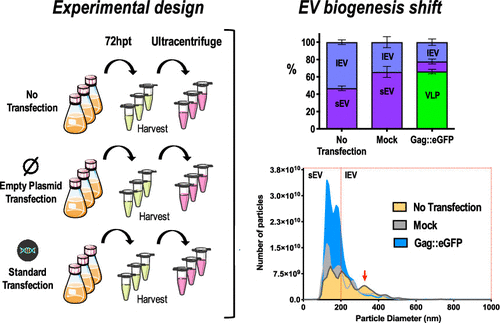当前位置:
X-MOL 学术
›
J. Proteome Res.
›
论文详情
Our official English website, www.x-mol.net, welcomes your feedback! (Note: you will need to create a separate account there.)
Molecular Characterization of the Coproduced Extracellular Vesicles in HEK293 during Virus-Like Particle Production
Journal of Proteome Research ( IF 4.4 ) Pub Date : 2020-09-25 , DOI: 10.1021/acs.jproteome.0c00581 Jesús Lavado-García 1 , Irene González-Domínguez 1 , Laura Cervera 1 , Inmaculada Jorge 2, 3 , Jesús Vázquez 2, 3 , Francesc Gòdia 1
Journal of Proteome Research ( IF 4.4 ) Pub Date : 2020-09-25 , DOI: 10.1021/acs.jproteome.0c00581 Jesús Lavado-García 1 , Irene González-Domínguez 1 , Laura Cervera 1 , Inmaculada Jorge 2, 3 , Jesús Vázquez 2, 3 , Francesc Gòdia 1
Affiliation

|
Vaccine therapies based on virus-like particles (VLPs) are currently in the spotlight due to their potential for generating high immunogenic responses while presenting fewer side effects than conventional vaccines. These self-assembled nanostructures resemble the native conformation of the virus but lack genetic material. They are becoming a promising platform for vaccine candidates against several diseases due to the ability of modifying their membrane with antigens from different viruses. The coproduction of extracellular vesicles (EVs) when producing VLPs is a key phenomenon currently still under study. In order to characterize this extracellular environment, a quantitative proteomics approach has been carried out. Three conditions were studied: non-transfected, transfected with an empty plasmid as control, and transfected with a plasmid coding for HIV-1 Gag polyprotein. A shift in EV biogenesis has been detected upon transfection, changing the production from large to small EVs. Another remarkable trait found was the presence of DNA being secreted within vesicles smaller than 200 nm. Studying the protein profile of these biological nanocarriers, it was observed that EVs were reflecting an overall energy homeostasis disruption via mitochondrial protein deregulation. Also, immunomodulatory proteins like ITGB1, ENO3, and PRDX5 were identified and quantified in VLP and EV fractions. These findings provide insight on the nature of the VLP extracellular environment defining the characteristics and protein profile of EVs, with potential to develop new downstream separation strategies or using them as adjuvants in viral therapies.
中文翻译:

HEK293 病毒样颗粒生产过程中同时产生的细胞外囊泡的分子表征
基于病毒样颗粒(VLP)的疫苗疗法目前备受关注,因为它们具有产生高免疫原性反应的潜力,同时比传统疫苗的副作用更少。这些自组装的纳米结构类似于病毒的天然构象,但缺乏遗传物质。由于能够用不同病毒的抗原修饰其膜,它们正在成为针对多种疾病的候选疫苗的有前景的平台。生产 VLP 时细胞外囊泡 (EV) 的共同产生是目前仍在研究的一个关键现象。为了表征这种细胞外环境,已经进行了定量蛋白质组学方法。研究了三种条件:未转染、用空质粒转染作为对照、以及用编码HIV-1 Gag多蛋白的质粒转染。转染后检测到 EV 生物发生的转变,将生产从大型 EV 改为小型 EV。另一个显着的特征是在小于 200 nm 的囊泡内分泌 DNA。研究这些生物纳米载体的蛋白质谱,观察到电动汽车反映了通过线粒体蛋白质失调而导致的整体能量稳态破坏。此外,还对 VLP 和 EV 组分中的 ITGB1、ENO3 和 PRDX5 等免疫调节蛋白进行了鉴定和定量。这些发现提供了对 VLP 细胞外环境性质的见解,定义了 EV 的特征和蛋白质谱,有可能开发新的下游分离策略或将其用作病毒疗法的佐剂。
更新日期:2020-11-06
中文翻译:

HEK293 病毒样颗粒生产过程中同时产生的细胞外囊泡的分子表征
基于病毒样颗粒(VLP)的疫苗疗法目前备受关注,因为它们具有产生高免疫原性反应的潜力,同时比传统疫苗的副作用更少。这些自组装的纳米结构类似于病毒的天然构象,但缺乏遗传物质。由于能够用不同病毒的抗原修饰其膜,它们正在成为针对多种疾病的候选疫苗的有前景的平台。生产 VLP 时细胞外囊泡 (EV) 的共同产生是目前仍在研究的一个关键现象。为了表征这种细胞外环境,已经进行了定量蛋白质组学方法。研究了三种条件:未转染、用空质粒转染作为对照、以及用编码HIV-1 Gag多蛋白的质粒转染。转染后检测到 EV 生物发生的转变,将生产从大型 EV 改为小型 EV。另一个显着的特征是在小于 200 nm 的囊泡内分泌 DNA。研究这些生物纳米载体的蛋白质谱,观察到电动汽车反映了通过线粒体蛋白质失调而导致的整体能量稳态破坏。此外,还对 VLP 和 EV 组分中的 ITGB1、ENO3 和 PRDX5 等免疫调节蛋白进行了鉴定和定量。这些发现提供了对 VLP 细胞外环境性质的见解,定义了 EV 的特征和蛋白质谱,有可能开发新的下游分离策略或将其用作病毒疗法的佐剂。

























 京公网安备 11010802027423号
京公网安备 11010802027423号